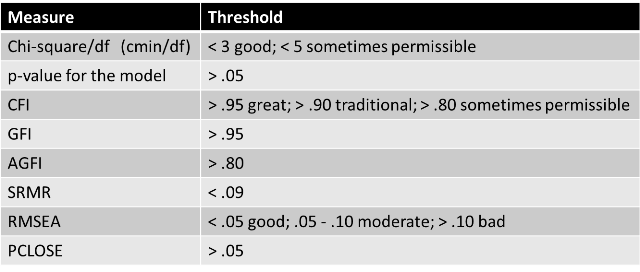Model Fitness in Confirmatory Factor Analysis (CFA)
Model fit refers to how well our proposed model (in this case, the model of the factor structure) accounts for the correlations between variables in the dataset. If we are accounting for all the major correlations inherent in the dataset (with regards to the variables in our model), then we will have good fit; if not, then there is a significant “discrepancy” between the correlations proposed and the correlations observed, and thus we have poor model fit. Our proposed model does not “fit” the observed or “estimated” model (i.e., the correlations in the dataset). Refer to the CFA video tutorial for specifics on how to go about performing a model fit analysis during the CFA.
Metrics
There are specific measures that can be calculated to determine goodness of fit. The metrics that ought to be reported are listed below, along with their acceptable thresholds. Goodness of fit is inversely related to sample size and the number of variables in the model. Thus, the thresholds below are simply a guideline. For more contextualized thresholds, see Table 12-4 in Hair et al. 2010 on page 654. The thresholds listed in the table below are from Hu and Bentler (1999).
Need Help with Data Analysis & Result Interpratation for your Project, Thesis or Dissertation?
We are Experts in SPSS, EVIEWS, AMOS, STATA, R, and Python
Modification indices
Modification indices offer suggested remedies to discrepancies between the proposed and estimated model. In a CFA, there is not much we can do by way of adding regression lines to fix model fit, as all regression lines between latent and observed variables are already in place. Therefore, in a CFA, we look to the modification indices for the covariances. Generally, we should not covary error terms with observed or latent variables, or with other error terms that are not part of the same factor. Thus, the most appropriate modification available to us is to covary error terms that are part of the same factor. The figure below illustrates this guideline – however, there are exceptions. In general, you want to address the largest modification indices before addressing more minor ones. For more information on when it is okay to covary error terms (however, some argue that there are never appropriate reasons to covary errors), refer to David Kenny’s thoughts on the matter: David’s website, or to the very helpful article: Hermida, R. 2015. “The Problem of Allowing Correlated Errors in Structural Equation Modeling: Concerns and Considerations,” Computational Methods in Social Sciences (3:1), p. 5.
Standardized Residual Covariances
Standardized Residual Covariances (SRCs) are much like modification indices; they point out where the discrepancies are between the proposed and estimated models. However, they also indicate whether or not those discrepancies are significant. A significant standardized residual covariance is one with an absolute value greater than 2.58. Significant residual covariances significantly decrease your model fit. Fixing model fit per the residuals matrix is similar to fixing model fit per the modification indices. The same rules apply. For a more specific run-down of how to calculate and locate residuals, refer to the CFA video tutorial. It should be noted however, that in practice, I never address SRCs unless I cannot achieve adequate fit via modification indices, because addressing the SRCs requires the removal of items.




